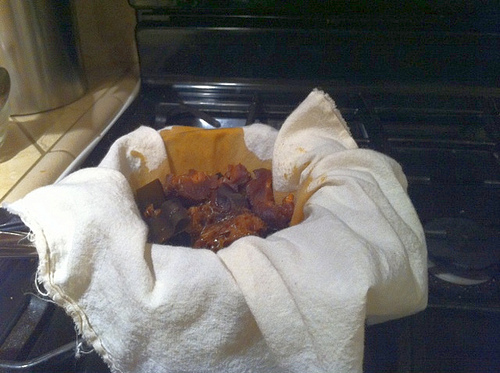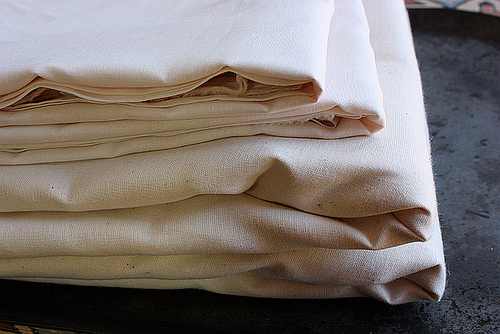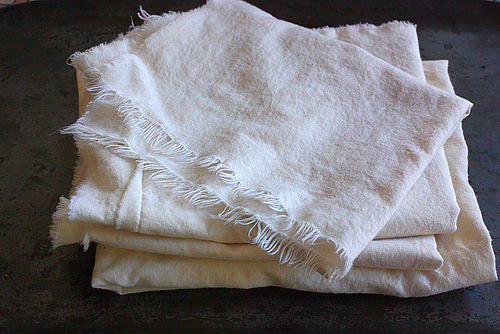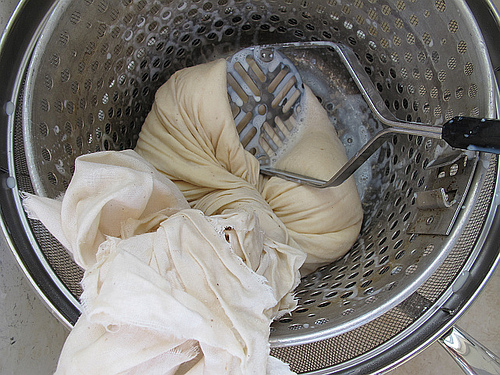I stopped using cheesecloth for cooking purposes about 2 years ago. It was expensive to purchase at markets and cookware shops. It got caught in my scissors at the most inconvenient times. It had to be discarded after each use. I got fed up and instead, turned to unbleached muslin. I have never looked back. Here are 5 reasons for using muslin in the kitchen:
1. Affordable – You can buy it by the yard at a fabric store for as little as $4 per yard.
2. Easy – Just tear it along the grain into the size you need. (I aim for 24 by 24-inch pieces but also have smaller odd-size pieces.) Snip an inch then pull the fabric apart with your hands. It should tear along its natural weave. No tricky sewing skills needed to neaten things up. The torn edges fray in the wash to develop a handsome appearance. Check out my stack above.
3. Washable and reusable – After using the muslin, immediately rinse and wring it out in the sink, then hang it up to dry. You don’t want to let wet fabric sit in your hamper for long. Launder the muslin with a load of laundry (we include it with the towels) and it’s ready for more kitchen duties.
4. Squeeze and press – Put salted napa cabbage or cucumber, or chunks of tofu into the piece of muslin and expel excess moisture. The relatively smooth texture of muslin means that liquid will pass through easily and lint won’t get stuck in your food. The cabbage for classic Chinese dumplings (jiaozi) is ready for mixing with other ingredients. The cucumber can receive a Vietnamese salad dressing because it's dryish and ready to absorb new flavors. Tofu for dumpling fillings (think Korean mandu) or meatballs get crushed and partially mashed as you massage and squeeze.
Muslin is also perfect for making soy milk as it doesn’t break like cheesecloth or flour sack towels. (I know from experience.) Plus, muslin is just porous enough to let the milk pass through without any soybeans solids going along for the ride.
You can scrape off the soy milk lees (okara) easily from muslin and there’s little waste. Food bits cling and get stuck in cheesecloth’s more open weave.
5. Strain – Use it for hassle-free straining of liquids, such as stocks and broths. Last night, I used muslin to strain a double batch of one of my favorite stealth ingredients, Japanese seasoned soy concentrate (Asian Tofu, page 208). It contains a number of ingredients including soy sauce, dried kelp, dried shiitake, and shaved bonito flakes, which can get messy for clean up; see the photo below. When I'm through with straining and pressing the soy concentrate, I dump the solids into the trash. I regularly use muslin to to produce a super clear dashi broth too.

I tend to use the same piece of muslin for pho and other super fragrant noodle soup broths because their perfume lingers for a few washings. The muslin tends to trap some of the fat too, which is fine as what fat does go through I keep in my pho broth.
Where and how to buy muslin for cooking purposes
Weight. Go for a lightweight unbleached (natural/buff color) muslin. Think of a shirt that you’d be happy to wear in the hot summer. The muslin will shrink after you wash it.

100% cotton, unbleached. That’s how most muslin is described. It’s pretty natural basic stuff. There’s no need to go fancy. Muslin is often described as being used for backing quilts. Tell the fabric store that you’re using the muslin to squeeze out soy milk or strain stocks. They will help you find the right bolt of fabric.
Choose a width. If you just need a couple pieces, buy a 48-inch-wide piece. Fabric is sold in different widths and muslin varies. There’s a super wide one that comes in 108-inch-width, which is what I eventually succumbed to.
Want to line a mold (like a tofu or cheese mold)? Use slightly lighter weight “voile” which will fall into place in your mold because it’s thinner than muslin and a shade lighter in color. In the above photo, the voile is on top so you can distinguish the weave difference. It looks just like muslin but is often in another part of the fabric store.
I really like this cheesecloth alternative. Maybe you've already discovered it (share your thoughts!) and enjoy it too.



















Duyen Nguyen says
I agreed. I tried your cumcumber salad yesterday and I wished I had that tool 🙂
Anyway, it tasted sooo good in this hot weather. Your book is my cooking bible!Thank you.
Andrea Nguyen says
Hi Duyen, the muslin fabric is a real time saver. Glad you liked the cucumber salad and "Into the Vietnamese Kitchen."
TinCook says
Have you had any problems with the muslin picking up any perfumes from the washer or dryer?
Andrea Nguyen says
We use fragrance-free detergent. Sometimes, my husband throws a dryer sheet but it is pretty rare. When he does use one, it doesn't seem to affect the food flavor in a noticeable. Good question!
Btw, we started using anti-static balls in the dryer. They are so-so and you have to use lots of them to see an effect. Here's an example: http://amzn.to/GU8xwp
candide says
That's a great tip. I gave up on cheesecloth about 10 years ago for all the reasons you mention. But I've just been cutting up old white cotton undershirts and t-shirts that were ready for the rag-bag. They work great, can be rewashed and reused indefinitely, and you can't beat the price. I bet old pillowcases would work too.
Mike says
thanks for the tip, think I'm gonna head over to the fabric store!
Mike
Alyssa (Everyday Maven) says
Hi Andrea! Great post. I also use muslin (and sometimes cheesecloth) for cooking but I find I don't get more than a handful of uses before it seems to dirty. Do you wash yours alone or with other towels, etc.?
Andrea Nguyen says
Alyssa, I wash each piece of muslin after every use. My husband does the laundry (:D) and he puts the muslin in with everything else.
Andrea Nguyen says
Go for it, Mike!
Andrea Nguyen says
Great tip on the t-shirts. I use them for polishing furniture. Pillowcases would work well -- especially cheap one. High count fabrics may have too fine of a weave. But why not? My mom used to cut up old fabric rice bags.
Thaivi says
Hi Andrea,
Can you use muslin to bag pho spices?
Thaivi
Andrea Nguyen says
Yes, you certainly can, Thaivi! Great suggestion.
Diane says
This is very timely! I just bought a new packet of cheese cloth and was grimbling about how much it was.
Jen says
Hey Andrea! Do you know what muslin is called in Vietnamese? I was thinking about getting some to make fresh soymilk! Google translated it as vải mỏng?
Leona says
Have anyone tried diaper cloth?
Meg says
Hi Andrea, I was wondering if I can use this to steam banh cuon? Thanks.
Dolt Gabi says
Good luck ,Great post,y love you!Thanks for the info it had cleared out too many things in my mind. Your recommendations are really good.
http://www.radishhealthbenefits.com
helen says
Thanks for this post!! I just bought some muslin and can't wait to start using it. I've been using kitchen towels to squeeze the excess liquid out but for finer things like homemade almond meal, it becomes a really yucky mess :).
Patty says
I love this thread! I am a quilter who has been educated as to the nuances of all the different fabrics, their quality, and how they perform in a quilt. It used to be that any "fabric" (I know they call it different things in different parts of the world/country) purchased in a chain store versus a quilt store was considered inferior, albeit cheap, goods. This especially applies to the inexpensive muslims. Cheaper fabric has a looser weave, higher quality has a tighter weave, I guess it all depends what you are using it for. When it comes to cheese, I would think that the cheaper muslim @ Joann's and the like would be fine. Afterall, the weave will be a lot tighter than cheesecloth. However, I don't think you want it as tight as the muslim you would select for a high quality quilt. I think the weave would be too tight and not allow the liquids/whey to pass through as need be.
One last word of advise, wash and dry all fabrics as soon as you bring them home, no fabric softener. This way you don't have to worry if they've been washed and dried, which can change the outcome of your project. For cheese, you just want unadulterated, looser weave, unprocessed (i.e. unbleached) muslim. Welcome all of you to fabric heaven!!!
Wendy says
Great idea! How do I prepare it for my first use? Do I wash and dry the whole yard or two I plan to buy, then tear out a piece of the size I want to use? Do I wash it by hand with laundry soap or something mild like woolite or no soap at all since it is brand new? Thank you.
sean jones says
Wrong! Blue disposable is the best as much more hygienic. Especially when dipped in 'hypo'. Normal washing machines can't guarantee bacteria is destroyed (obviously coagulating agents are basically bacteria).
Can you trace back to where it is made? i.e. is it made in a food grade facility with ISO 9001/ 14001 accreditation? Or Brc accreditation (global hygiene and packaging). If not then I'd be reluctant to eat anything made using the material you recommended.
Blue disposable is obviously disposable! And very cheap. You can buy 500 for about $30!
Moirraine says
If you do you might have a heck of a buildup - air dry or clean out your dryer with vinegar before drying towels or muslin.
Never use dryer sheets or softener with towels - and DO rinse them at least twice a month in two cups of vinegar to a full wash of towels in hot water to rid them of body oils and left-in-hard-water-soap and deposits.
I dare anyone to run a load of towels with nothing more than hot water and vinegar, take a look after a few moments of agitation - and then see what you've been redepositing on your body every single day.
Thanks for the Muslin idea - I wish there were more people like you near me to learn from in person.
robert says
I am a budding salami ( salumi ) maker, and muslin is a traditional way to make dry sausages.
Thanks for the information about thin muslin, and food type cloth, it was a big help.
Andrea Nguyen says
Muslin rocks! So glad you use it, too. Cheesecloth is not the best and only option.
Kirsten says
Can muslin or voile be used in making Greek yogurt? I'm looking for an alternate when straining the yogurt so I don't have to keep using cheesecloth, and I don't want to buy a yogurt strainer..
Andrea Nguyen says
I've used muslin and it's great. There's one that's somewhat more porous and I think it has a little polyester in it. You can see it in this recipe I wrote for making yogurt in the Instant Pot:
https://www.vietworldkitchen.com/blog/2017/09/instant-pot-vietnamese-yogurt-recipe.html
Linda Nguyen says
Hey K,
I always use cheesecloths for making greek yogurt and love it. Have no issues what so ever but I also used ultra fine cheesecloth when doing so. Andrea does have a good point about the pains of cutting it but I use this brand on amazon which I'll link below that doesn't fray at all! It's good quality for straining yogurt and helps me make jams too. I've never tried using muslin but I'll have to try that out. Hope it helps you out dear!
https://www.amazon.com/dp/B07HY86VG7?ref=myi_title_dp
Andrea Nguyen says
Thanks for the heads up on the ultra fine cheesecloth! Muslin is pretty awesome stuff and I have some that have been in use for years.
vimal says
- only organic cotton
- before first use soak 24 hr in baking soda to clean out
Andrea Nguyen says
Thanks for the tip. You rinse the muslin after the soaking right?
Jenny Ngo says
Thanks for the tip. I came across your blog when looking for an alternative to use for making banh cuon.
Have you used it for that purpose?
Andrea Nguyen says
I'd look for fabric with some polyester. That's what my banh cuon fabric seems to have. That likely will ensure a somewhat nonstick surface.
Jaime O'Leary says
Thank you so much for this article on using muslin. I am new to Asian cooking techniques and I had quite a hard time searching for the appropriate material with which to make bags for steaming rice. Everywhere I previously searched mentioned parchment paper linings for bamboo steamers or to use cheesecloth, but I thought it was much to big a weave to use with rice. It just didn't feel right to use. I look forward to watching your videos. 🙂 Thanks again!
Andrea Nguyen says
Oh my, cheesecloth for sticky rice sounds like mess in the making! Yes, try muslin. Banana leaves work too, but you have to find those at Asian or Latin markets.
When I steam sticky rice in a metal steamer, I don't line the trays at all. If you use a bamboo steamer then yes, lining is necessary. Thanks for cooking and commenting.
John Sumpterusa says
Thank you for sharing this. Muslin is very soft stuff and it saves money in the long run!